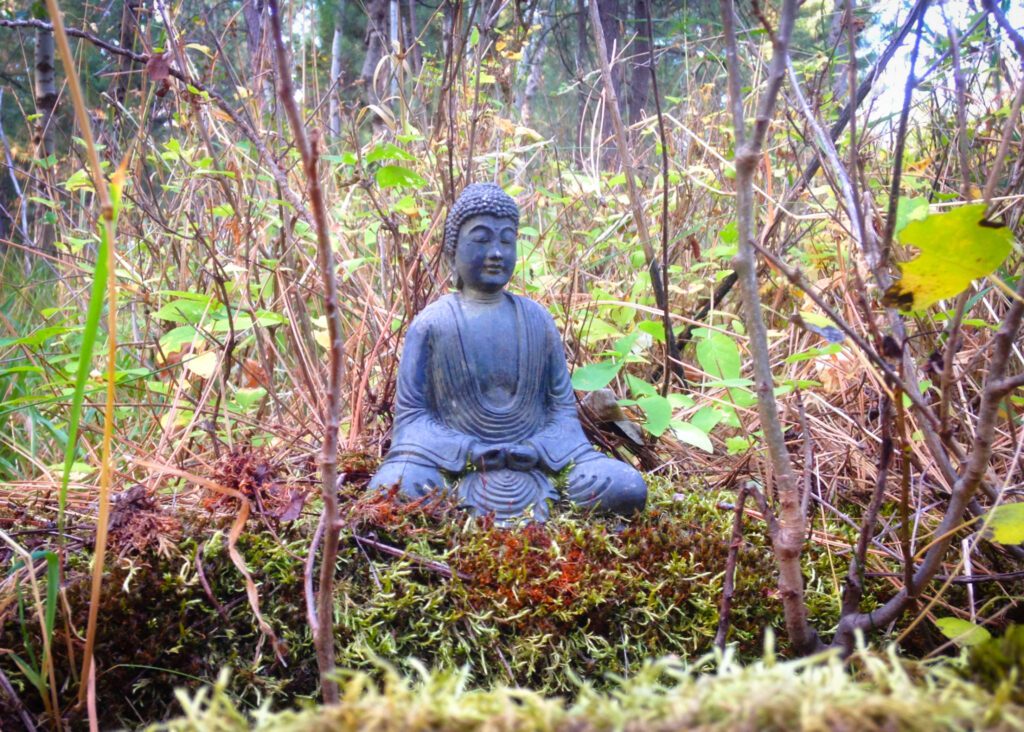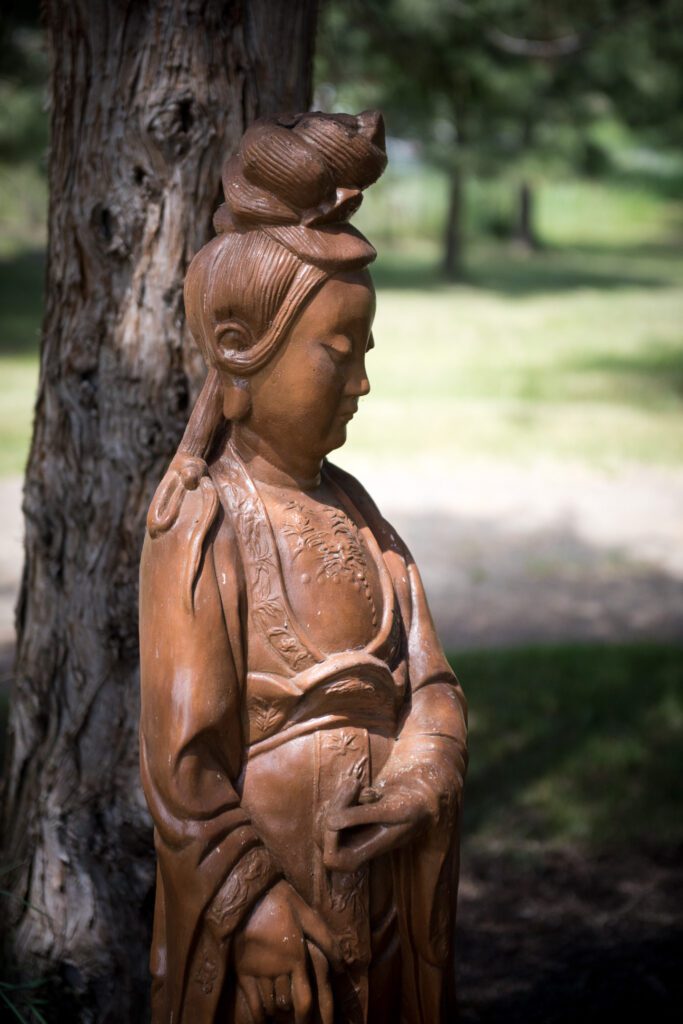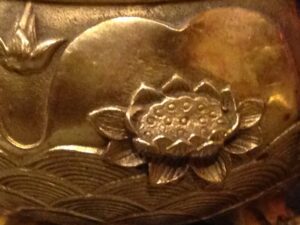On statues and ceremonial in a Soto Zen temple.
Question:
If everything has Buddha Nature, why does a Zen temple have statues, and what is the purpose of doing Buddhist ceremonial?
Answer:
To help set all beings free.
Explanation:
WE SEEK FREEDOM FROM SUFFERING
Although all beings have the Buddha Nature, when we human beings cling to anything, we suffer. This is true whatever the object of our clinging, including our opinions and ideals. Whenever we cling, we lose sight of that which is compassionate, loving and wise, and fall headlong into the trap of our greeds, hatreds, and delusions. All Buddhist Teaching is essentially the showing of the Path that leads to liberation from suffering, if a person chooses to let go of where they cling, and follow where the teaching leads.
Buddhism offers this Teaching (“Dharma”) in as many different forms as there are those who seek the Truth. These many forms include Dharma talks (formal lectures from a teacher), scriptures which may be read or recited or sung aloud, the living example of those who follow the path, traditional ceremonial as passed down through the ages, and iconography.
ICONOGRAPHY & CEREMONIAL ASSIST
Iconography means any kind of picture, carving, or sculpture of Buddhas (“wise ones” or “awakened ones”), Bodhisattvas (“enlightened beings” or “beings on the way to enlightenment”). Also depicted often are great teachers from throughout the twenty-five centuries of Buddhist history, or even great Buddhist teachings represented visually in human form.
Buddhist iconography ranges from the small and simple to the immense and complex, with many variations in between. In much Buddhist imagery, even the smallest details have significance and effect, especially when repeated regularly. This is also true of even the simplest ritual activities in which both monastic and lay Buddhists participate, as well as daily services and yearly festival celebrations, rites of passage, and monastic ceremonies, all of which may be regarded as “ceremonial” in Zen practice.
The action of lighting and then offering a stick of incense at an altar, for example, points out the temporary nature of what we think of as a solid self, which may be transformed through the process of training “as if your hair were on fire,” in other words, with much energy! As the incense stick burns in an incense burner, it turns to ash, as the pleasant scent that remains is released and permeates everything nearby.
ExPRESSING THE TEACHING
Similarly, the cookies we enjoy during our Sunday morning tea and Dharma discussion let us taste the sweetness of the sharing of the Teaching, when we offer and receive it together. And when the congregation sings a scripture or invocation together, we express the Teaching through our own bodies and voices, giving it life and absorbing it at the same time.
When we mark important life transitions with a ceremony such as a Buddhist wedding, memorial, or baby-naming, we are including at these important times a reminder of the Buddha’s teachings on setting beings free from suffering. Even as we celebrate together with joy the many aspects of growth and change within this transient human life, we are asking for help from all that is benevolent in the universe to watch over and guide us as we find our way, as we step forward with courage into the Unknown.

BUDDHA EVERYWHERE
The statues and images at a Buddhist Temple are meant to convey a simple teaching: that all beings have the Buddha Nature and are, at heart, Buddha. The Buddha Nature is everywhere; a Buddha statue essentially says “Look! Here’s yet another form of Buddha!” When you are looking at a Buddha statue, you are looking in a bright mirror. Whom do you see?
CLARIFYING QUALITIES OF BUDDHA
Each temple statue represents a specific quality of Buddha Nature which clarifies and emerges with practice over time, such as Great Compassion, Great Love, or Great Wisdom, among many many others. Looking at an image of a Buddha is like reading a scripture or hearing a recorded Dharma talk: if we look, read, or listen carefully, we can all learn a lot about ourselves and each other. In any one statue, each of us may see a different teaching, something that is unique and useful to us at this particular time.
On the temple grounds or in a garden, a stone statue may stand in a peaceful shrine, with a bench placed opposite the statue for someone to sit quietly before Kanzeon (Bodhisattva of Great Compassion). A person may be drawn to such a quiet spot, to take time to reflect before the image of a calmly smiling lady pouring cool water (the waters of compassion).

HOW IMAGERY HELPS
Perhaps the image of gentle compassion may help someone to ponder more deeply on making a wise decision at a crossroads in life’s journey, or to open to choosing the most compassionate means of livelihood for fulfilling their true purpose. Or maybe the stillness of the immovable stone figure simply may help someone to grow still. If you are taken by any particular Buddhist icon, it may help to ask a monk for teaching about the position it’s in or what the image is holding, and it also may help just to open your heart as you come closer to the image.
In performing our daily monastic office and other ceremonies before the main altar, Buddhist monks and laypeople are showing appreciation for various aspects of Buddha Nature symbolized and invoked in the scriptures we recite. When we stand, sit or bow before a statue or altar, we are offering respect and reverence for what they represent.

All images of Buddhas and Bodhisattvas are respectfully covered up during this ancient and compassionate Mahayana Buddhist ceremony.
When we gather at a shrine altar, the central image helps us focus on a particular aspect of teaching. In some ceremonies there is no Buddha image, to help beings who may be put off by one; that itself is one of the teachings of those ceremonies.
GESTURES OF OFFERING, RECOGNITION, aND CARE
In just about every Soto Zen ceremony, any merit we may accrue by doing the ceremony is offered up at some point, passed on to be of help for someone or something specific, or shared with all beings everywhere.
Likewise, when Buddhists chance to meet, we put our hands palms together at the heart and sometimes also bow from the waist toward each other. These gestures (“gassho” and “monjin” in Japanese) indicate our recognition of the sacred in each other. (Similar gestures of respect and reverence are also practiced in many other of the world’s religions.) This is a ceremony.
Likewise, when we come to our sitting place for meditation, at home or at the temple, we bow (monjin) to our seat, then turn and bow to all the others who are sitting with us whether they are in the room or sitting far away. This is out of gratitude for a place to sit, and a reminder that we are not separate from this world around us. This is a form of ceremonial.
Likewise, when we go to enter a temple, we take off our shoes, placing them neatly outside the door so that others won’t stumble over them. Then, stepping inside the temple, we bow from the waist or perhaps even all the way to the floor; this is out of gratitude for the temple’s existence. In this way, we also bring our mind to stillness, becoming fully present right where we are with this one thing we are doing. All this, too, is a ceremony.

When bowing deeply, Buddhists are physically acknowledging that there is something beyond this one small self, something we may all enter into as, opening to include the self, we are becoming One.
EXPRESSION BEYOND WORDS
Ceremonial, like choreography, can sometimes express a whole sequence of teachings, like a Dharma article. Most of Soto Zen ceremony originated in medieval Japan with Great Master Keizan Jokin, grand-disciple of Great Master Dogen. Keizan wished to make the teaching clear and accessible to everyone, without the need for words.
As a result, our ceremonial shows the Buddha’s teaching of liberation, rather than explaining it; and when we take part, we are able to embody it for ourselves. This is far beyond merely gaining an intellectual understanding.

And because of this, also, we need not worry if we don’t “know” what the ceremony means or “get” what the statue stands for. We can look, listen, smell, taste, join in, and follow along, and trust that the teaching will reveal itself as needed and in good time, and just for us.
PARTICIPANTS BENEFIT, ALL BEINGS BENEFIT
A ceremony is not done for the benefit of the statue on the altar; the statue on the altar is there for the benefit of the people doing the ceremony! Statues are reminders, symbols, reflections of what an observer may find within their own heart by turning within. Each ceremony offers a wealth of teaching for the participants to discover for themselves.
Ceremonial offers the example of a living, breathing, moving bridge between formal sitting and the ceremony of our real life, as the path of training naturally unfolds. Just as we may come to find our seat as we deepen our meditation practice, so may we discover the natural joy and flow of living a Preceptual life as we follow our true heart.
For the Teaching that leads to true freedom and peace of heart is not limited to a ceremony, and the Buddha Nature cannot be confined to a statue. Though Buddha and Dharma may be embodied in statues and ceremonial, it is through their expression by those who practice the Buddhadharma wholeheartedly that the truth of the teaching truly comes to life, and helps set beings free.

The above image shows a temple statue depicting the Buddhist Teaching on “Setting All Beings Free.” A young monk gently releases a captured fish into a pond, to live and swim free, as the fish was born to do. The fish represents the self caught by clinging; the kind monk represents our innate Buddha Nature that lets go of self by acting naturally from compassion.
— Dharma offering by Rev. Clairissa Beattie
